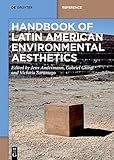Handbook of Latin American Environmental Aesthetics / ed. by Jens Andermann, Gabriel Giorgi, Victoria Saramago.
Material type: TextSeries: De Gruyter HandbookPublisher: Berlin ; Boston : De Gruyter, [2023]Copyright date: ©2023Description: 1 online resource (XI, 493 p.)Content type:
TextSeries: De Gruyter HandbookPublisher: Berlin ; Boston : De Gruyter, [2023]Copyright date: ©2023Description: 1 online resource (XI, 493 p.)Content type: - 9783110775877
- 9783110775969
- 9783110775907
- Aesthetics, Latin American -- Environmental aspects -- Handbooks, manuals, etc
- Arts -- Environmental aspects -- Latin America
- Anthropozän
- Lateinamerika
- Post-Extraktivismus
- Ökokritik
- Ökologische Naturästhetik
- LITERARY CRITICISM / European / Spanish & Portuguese
- Anthropocene
- Latin America
- ecocriticism
- environmental aesthetics
- postextractivism
- 111.85098 23/eng/20230918
- BH301.E58 H36 2023
- online - DeGruyter
- Issued also in print.
| Item type | Current library | Call number | URL | Status | Notes | Barcode | |
|---|---|---|---|---|---|---|---|
 eBook
eBook
|
Biblioteca "Angelicum" Pont. Univ. S.Tommaso d'Aquino Nuvola online | online - DeGruyter (Browse shelf(Opens below)) | Online access | Not for loan (Accesso limitato) | Accesso per gli utenti autorizzati / Access for authorized users | (dgr)9783110775907 |
Frontmatter -- Contents -- List of Illustrations -- Introduction -- Itineraries -- Ecocriticism -- Extractivism -- Multinaturalism/Nonhuman Representation -- Keywords -- Animal -- Climate -- Contagion -- Desert -- Extinction -- Feminisms -- Forest -- Geology -- Indigeneity -- Infrastructure -- Labor -- Land/Body -- Landscape -- Matter -- Mining -- Monoculture -- Oil -- Plant -- Race -- Resilience -- Strata -- Toxicity -- Trance -- Water -- Coda -- Planetarity as Radical Heterogeneity: A Conversation with Mary Louise Pratt -- List of Contributors -- Index
restricted access online access with authorization star
http://purl.org/coar/access_right/c_16ec
The Handbook of Latin American Environmental Aesthetics offers a comprehensive overview of Latin American aesthetic and conceptual production addressing the more-than-human environment at the intersection between art, activism, and critique. Fields include literature, performance, film, and other audiovisual media as well as their interactions with community activisms. Scholars who have helped establish environmental approaches in the field as well as emergent critical voices revisit key concepts such as ecocriticism, (post-)extractivism, and multinaturalism, while opening new avenues of dialogue with areas including critical race theory and ethnicity, energy humanities, queer-*trans studies, and infrastructure studies, among others. This volume both traces these genealogies and maps out key positions in this increasingly central field of Latin Americanism, at the same time as they relate it to the environmental humanities at large. By showing how artistic and literary productions illuminate critical zones of environmental thought, articulating urgent social and material issues with cultural archives, historical approaches and conceptual interventions, this volume offers cutting-edge critical tools for approaching literature and the arts from new angles that call into question the nature/culture boundary.
Issued also in print.
Mode of access: Internet via World Wide Web.
In English.
Description based on online resource; title from PDF title page (publisher's Web site, viewed 26. Apr 2024)


